
Chrysler Airflow
Encyclopedia
The Chrysler Airflow is an automobile
produced by the Chrysler Corporation
from 1934-1937. The Airflow was the first full-size American production car to use streamlining
as a basis for building a sleeker automobile, one less susceptible to air resistance
. Chrysler made the first effort at a fundamental change in automotive design with the Chrysler Airflow, but it was ultimately a commercial failure.

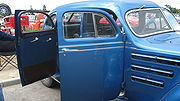
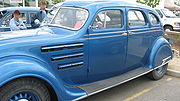

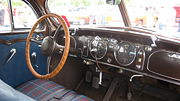 Breer, along with fellow Chrysler engineers Fred Zeder and Owen Skelton, began a series of wind tunnel tests, with the cooperation of Orville Wright, to study which forms were the most efficient shape created by nature that could suit an automobile. Chrysler built a wind tunnel at the Highland Park
Breer, along with fellow Chrysler engineers Fred Zeder and Owen Skelton, began a series of wind tunnel tests, with the cooperation of Orville Wright, to study which forms were the most efficient shape created by nature that could suit an automobile. Chrysler built a wind tunnel at the Highland Park
site, and tested at least 50 scale models by April 1930. Their engineers found that then-current two-box automobile design was so aerodynamically inefficient, that it was actually more efficient turned around backwards. Applying what they had learned about shape, the engineers also began looking into ways that a car could be built, which also used monocoque (unibody) construction to both strengthen the construction (the strengthening was used in a publicity reel ) of the car while reducing its overall drag, and thus increasing the power-to-drag ratio as the lighter, more streamlined body allowed air to flow around it instead of being caught through upright forms, such as radiator grilles, headlights and windshields.
Traditional automobiles of the day were the typical two-box design, with about 65% of the weight over the rear wheels. When loaded with passengers, the weight distribution tended to become further imbalanced, rising to 75% or more over the rear wheels, resulting in unsafe handling characteristics on slippery roads. Spring rates in the rear of traditional vehicles were, therefore, necessarily higher, and passengers were subjected to a harsher ride.
An innovative suspension system on the new Chrysler Airflow stemmed from the need for superior handling dynamics
. The engine was moved forward over the front wheels compared with traditional automobiles of the time, and passengers were all moved forward so that they were seated within the wheelbase
, rather than on top of the rear axle. The weight distribution had approximately 54% of the weight over the front wheels, which evened to near 50-50 with passengers, and resulted in more equal spring rates, better handling, and far superior ride quality.
The Airflow, which was heavily influenced by streamlining design movement, was sleek and low compared to other cars on American roads. The car's grille work cascaded forward and downward forming an waterfall look where other makes sported bolt-upright radiators. Headlights were semi-flush to areas immediate to the grille. The front fenders enclosed the running surface of the tire tread. In the rear, Airflows encased the rear wheels through the use of fender skirts
.
Instead of a flat panel of glass, the windshield comprised two sheets of glass that formed a raked "vee" both side to side, and top to bottom. Passengers were carried in a full steel body (at a time when automakers like General Motors
, Ford
and even Chrysler itself continued to use wood structural framing members in their car bodies) that rested between the wheels instead of upon them. The front seat was wider than in other cars and the rear seat was deeper. Overall, the car possessed a better power-to-weight ratio, and its structural integrity was stronger than other like models of the day.
The car was introduced months(in January, 1934) before it was put in production, and production peaked at only 6,212 units in May 1934 — very late in the year and barely enough to give every dealer a single Chrysler Airflow. The factory had not accounted for significant manufacturing challenges and expense due to the unusual new Airflow design, which required an unprecedented number and variety of welding techniques. The early Airflows arriving at dealerships suffered from significant problems, mostly the result of faulty manufacturing. According to Fred Breer, son of Chrysler Engineer Carl Breer, the first 2,000 to 3,000 Airflows to leave the factory had major defects including engines breaking loose from their mountings at 80 mph (128.7 km/h).
, were scheduled to offer the Airflow. DeSoto was assigned to offer nothing but Airflows; Chrysler, however, hedged its bets and continued to offer a six-cylinder variant of its more mainstream 1933 model cars. The Airflow used a flathead
I8
engine and was produced in both 2-door coupe
and 4-door sedan variants. It is believed that only three 1934 Imperial Airflows still exist.
Chrysler of Canada produced an Airflow Six, model CY, which was basically a DeSoto Airflow with a Chrysler grille, bumpers, instrument panel and emblems. A total of 445 were built. The Airflow Six was dropped at the end of 1934.
The Chrysler line of eight cylinder Airflows included model CU Airflow Eight (123.5 in (3,136.9 mm) wheelbase), model CV Airflow Imperial Eight (128 in (3,251.2 mm) wheelbase), model CX Airflow Custom Imperial (137.5 in (3,492.5 mm) wheelbase). At the very top was the model CW Airflow Custom Imperial with a body built by LeBaron on a 146.5 in (3,721.1 mm) wheelbase. The CW had the industry's first one-piece curved windshield on a production automobile.
Within six months of the Airflow's introduction, the vehicle was a sales disaster. Adding insult to injury, General Motors mounted an advertising campaign aimed at further discrediting the Airflows. Most automotive historians, though, agree that the Airflow was shunned in large part because buyers did not like its looks. The hood, waterfall
grille
, headlamp
s, and fenders
were all merged into one continuous form that was interpreted as an "anonymous lump". While thoroughly modern, the public was slow to embrace the Airflow. At the depth of the Great Depression
, the car seemed to be too advanced, too different for many consumers. While Airflows sold in respectable numbers in its first year, Chrysler's traditional sedans and coupes far outsold the Airflow by 2.5 to one, with first year Airflow sales at 10,839 units.
DeSoto fared far worse than Chrysler for 1934. Without any "standard" car to sell, DeSoto's sales numbers plunged. And while the Airflow design looked somewhat sleek on the Chrysler's longer wheelbase, the DeSoto appeared to be short and stubby.
Rumors also persisted that the "new-fangled" body was unsafe, which was mostly untrue. In one widely distributed advertising film shown in movie theatres, an empty Airflow was pushed off a Pennsylvania
cliff, falling over 110 ft (33.5 m); once righted, the car was driven off, battered, but recognizable.
Chrysler also introduced an all-steel standard car, which it and DeSoto sold as the Chrysler Airstream
and DeSoto Airstream
. The Airstream was popular and outsold the Airflow models because, while the Airflow was streamlined, the Airstream only looked streamlined.
The Airflow models offered for 1935 were the same as in 1934, with the exception of the Airflow Eight two door sedan which was dropped. Chrysler Airflow production dipped below 8,000 units for 1935, with roughly four Airstreams produced for every Airflow.
. The historic vehicle was restored in 1978 and is on display in Quezon City
, Philippines
. Another 1937 Airflow Custom Imperial, model CW*, limousine was owned by radio personality Major Edward Bowes , Chrysler was one of Bowes' radio show sponsors. The two Airflow Custom Imperials were actually leftover 1935 models and only the two were built for 1937.
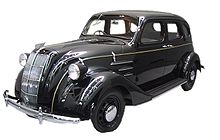
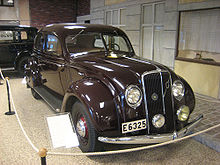 While the Airflow may have signaled Chrysler's attempt to set itself apart from other manufacturers, the failure of the car in the marketplace caused the company to take a more conservative path with its future models. Until the debut of Virgil Exner
While the Airflow may have signaled Chrysler's attempt to set itself apart from other manufacturers, the failure of the car in the marketplace caused the company to take a more conservative path with its future models. Until the debut of Virgil Exner
's "Forward Look
" cars of 1955, Chrysler's corporate styling was conservative and mainstream.
It is rumoured that Ferdinand Porsche
imported an early Airflow coupe into Germany, and using this model for "inspiration", designed the first Volkswagen. The similarities between early Volkswagens and the Airflow coupes could be a testimony to this hypothesis.. However, the general lines of the KDF-Wagen were drawn as early as 1932, and the Czech Tatra T97
is a far more likely inspiration.
or Duesenberg
, many die-cast toy
models are still available, and one die-cast pre-war toy sold on eBay
in 2006 for US$5,000, which is about what these cars cost new.
's print/sculpture "Profile Airflow", featuring a lithograph of the car beneath a superimposed aquamarine resin relief. The initial resin in the initial printing faded to an olive green color and was thus recalled by Claes Oldenburg
and Gemini G.E.L., the printmaking studio which fabricated "Profile Airflow".
"Profile Airflow" is especially significant because it revolutionized the idea of a print, expanding it to include serialized sculpture.
Automobile
An automobile, autocar, motor car or car is a wheeled motor vehicle used for transporting passengers, which also carries its own engine or motor...
produced by the Chrysler Corporation
Chrysler
Chrysler Group LLC is a multinational automaker headquartered in Auburn Hills, Michigan, USA. Chrysler was first organized as the Chrysler Corporation in 1925....
from 1934-1937. The Airflow was the first full-size American production car to use streamlining
Streamliner
A streamliner is a vehicle incorporating streamlining in a shape providing reduced air resistance. The term is applied to high-speed railway trainsets of the 1930s to 1950s, and to their successor "bullet trains". Less commonly, the term is applied to fully faired recumbent bicycles...
as a basis for building a sleeker automobile, one less susceptible to air resistance
Drag (physics)
In fluid dynamics, drag refers to forces which act on a solid object in the direction of the relative fluid flow velocity...
. Chrysler made the first effort at a fundamental change in automotive design with the Chrysler Airflow, but it was ultimately a commercial failure.
Genesis of the Airflow project
The basis for the Chrysler Airflow was rooted in Chrysler Engineering's Carl Breer's curiosity about how forms affected their movement through the environment. According to Chrysler, Breer's quest was started while watching geese travel through the air in a "V" flight pattern. Another source lists Breer as watching military planes on their practice maneuvers, while still other sources attach the genesis of the project to Breer's interest in lighter than air airships and how their shapes helped them move through the atmosphere.




Highland Park, Michigan
- Geography :According to the United States Census Bureau, the city has a total area of , all land.- Demographics :As of the census of 2000, there were 16,746 people, 6,199 households, and 3,521 families residing in the city. The population density was 5,622.9 per square mile . There were 7,249...
site, and tested at least 50 scale models by April 1930. Their engineers found that then-current two-box automobile design was so aerodynamically inefficient, that it was actually more efficient turned around backwards. Applying what they had learned about shape, the engineers also began looking into ways that a car could be built, which also used monocoque (unibody) construction to both strengthen the construction (the strengthening was used in a publicity reel ) of the car while reducing its overall drag, and thus increasing the power-to-drag ratio as the lighter, more streamlined body allowed air to flow around it instead of being caught through upright forms, such as radiator grilles, headlights and windshields.
Traditional automobiles of the day were the typical two-box design, with about 65% of the weight over the rear wheels. When loaded with passengers, the weight distribution tended to become further imbalanced, rising to 75% or more over the rear wheels, resulting in unsafe handling characteristics on slippery roads. Spring rates in the rear of traditional vehicles were, therefore, necessarily higher, and passengers were subjected to a harsher ride.
An innovative suspension system on the new Chrysler Airflow stemmed from the need for superior handling dynamics
Car handling
Automobile handling and vehicle handling are descriptions of the way wheeled vehicles perform transverse to their direction of motion, particularly during cornering and swerving. It also includes their stability when moving at rest. Handling and braking are the major components of a vehicle's...
. The engine was moved forward over the front wheels compared with traditional automobiles of the time, and passengers were all moved forward so that they were seated within the wheelbase
Wheelbase
In both road and rail vehicles, the wheelbase is the distance between the centers of the front and rear wheels.- Road :In automobiles, the wheelbase is the horizontal distance between the center of the front wheel and the center of the rear wheel...
, rather than on top of the rear axle. The weight distribution had approximately 54% of the weight over the front wheels, which evened to near 50-50 with passengers, and resulted in more equal spring rates, better handling, and far superior ride quality.
The Airflow debuts
Prior to the Airflow's debut, Chrysler did a publicity stunt in which they reversed the axles and steering gear, which allowed the car to be driven "backwards" throughout Detroit. The stunt caused a near panic, but the marketing department felt that this would send a hint that Chrysler was planning something big. The car that emerged was like no other American production car to date.The Airflow, which was heavily influenced by streamlining design movement, was sleek and low compared to other cars on American roads. The car's grille work cascaded forward and downward forming an waterfall look where other makes sported bolt-upright radiators. Headlights were semi-flush to areas immediate to the grille. The front fenders enclosed the running surface of the tire tread. In the rear, Airflows encased the rear wheels through the use of fender skirts
Fender skirts
Fender skirts, known in Australia and the United Kingdom as spats, are pieces of bodywork on the fender that cover the upper portions of the rear tires of an automobile.-Functions:...
.
Instead of a flat panel of glass, the windshield comprised two sheets of glass that formed a raked "vee" both side to side, and top to bottom. Passengers were carried in a full steel body (at a time when automakers like General Motors
General Motors
General Motors Company , commonly known as GM, formerly incorporated as General Motors Corporation, is an American multinational automotive corporation headquartered in Detroit, Michigan and the world's second-largest automaker in 2010...
, Ford
Ford Motor Company
Ford Motor Company is an American multinational automaker based in Dearborn, Michigan, a suburb of Detroit. The automaker was founded by Henry Ford and incorporated on June 16, 1903. In addition to the Ford and Lincoln brands, Ford also owns a small stake in Mazda in Japan and Aston Martin in the UK...
and even Chrysler itself continued to use wood structural framing members in their car bodies) that rested between the wheels instead of upon them. The front seat was wider than in other cars and the rear seat was deeper. Overall, the car possessed a better power-to-weight ratio, and its structural integrity was stronger than other like models of the day.
The car was introduced months(in January, 1934) before it was put in production, and production peaked at only 6,212 units in May 1934 — very late in the year and barely enough to give every dealer a single Chrysler Airflow. The factory had not accounted for significant manufacturing challenges and expense due to the unusual new Airflow design, which required an unprecedented number and variety of welding techniques. The early Airflows arriving at dealerships suffered from significant problems, mostly the result of faulty manufacturing. According to Fred Breer, son of Chrysler Engineer Carl Breer, the first 2,000 to 3,000 Airflows to leave the factory had major defects including engines breaking loose from their mountings at 80 mph (128.7 km/h).
1934
For 1934, both Chrysler and its junior running mate, DeSotoDeSoto Airflow
The DeSoto Airflow was an automobile built by the Chrysler Corporation for sale through its DeSoto division during model years 1934, 1935 and 1936. DeSoto received the then-revolutionary Airflow model due to its price structure relationship to larger and more expensive Chrysler brand cars. The 1934...
, were scheduled to offer the Airflow. DeSoto was assigned to offer nothing but Airflows; Chrysler, however, hedged its bets and continued to offer a six-cylinder variant of its more mainstream 1933 model cars. The Airflow used a flathead
Flathead engine
A flathead engine is an internal combustion engine with valves placed in the engine block beside the piston, instead of in the cylinder head, as in an overhead valve engine...
I8
Straight-8
The straight-eight engine or inline-eight engine is an eight-cylinder internal combustion engine with all eight cylinders mounted in a straight line along the crankcase...
engine and was produced in both 2-door coupe
Coupé
A coupé or coupe is a closed car body style , the precise definition of which varies from manufacturer to manufacturer, and over time...
and 4-door sedan variants. It is believed that only three 1934 Imperial Airflows still exist.
Chrysler of Canada produced an Airflow Six, model CY, which was basically a DeSoto Airflow with a Chrysler grille, bumpers, instrument panel and emblems. A total of 445 were built. The Airflow Six was dropped at the end of 1934.
The Chrysler line of eight cylinder Airflows included model CU Airflow Eight (123.5 in (3,136.9 mm) wheelbase), model CV Airflow Imperial Eight (128 in (3,251.2 mm) wheelbase), model CX Airflow Custom Imperial (137.5 in (3,492.5 mm) wheelbase). At the very top was the model CW Airflow Custom Imperial with a body built by LeBaron on a 146.5 in (3,721.1 mm) wheelbase. The CW had the industry's first one-piece curved windshield on a production automobile.
Within six months of the Airflow's introduction, the vehicle was a sales disaster. Adding insult to injury, General Motors mounted an advertising campaign aimed at further discrediting the Airflows. Most automotive historians, though, agree that the Airflow was shunned in large part because buyers did not like its looks. The hood, waterfall
Waterfall
A waterfall is a place where flowing water rapidly drops in elevation as it flows over a steep region or a cliff.-Formation:Waterfalls are commonly formed when a river is young. At these times the channel is often narrow and deep. When the river courses over resistant bedrock, erosion happens...
grille
Grille
A grille or grill is an opening of several slits side by side in a wall or metal sheet or other barrier, usually to let air or water enter and/or leave but keep larger objects including people and animals in or out.-Spelling:In the United States, "grille" is used to differentiate the automotive...
, headlamp
Headlamp
A headlamp is a lamp, usually attached to the front of a vehicle such as a car or a motorcycle, with the purpose of illuminating the road ahead during periods of low visibility, such as darkness or precipitation. Headlamp performance has steadily improved throughout the automobile age, spurred by...
s, and fenders
Fender (vehicle)
Fender is the US English term for the part of an automobile, motorcycle or other vehicle body that frames a wheel well . Its primary purpose is to prevent sand, mud, rocks, liquids, and other road spray from being thrown into the air by the rotating tire. Fenders are typically rigid and can be...
were all merged into one continuous form that was interpreted as an "anonymous lump". While thoroughly modern, the public was slow to embrace the Airflow. At the depth of the Great Depression
Great Depression
The Great Depression was a severe worldwide economic depression in the decade preceding World War II. The timing of the Great Depression varied across nations, but in most countries it started in about 1929 and lasted until the late 1930s or early 1940s...
, the car seemed to be too advanced, too different for many consumers. While Airflows sold in respectable numbers in its first year, Chrysler's traditional sedans and coupes far outsold the Airflow by 2.5 to one, with first year Airflow sales at 10,839 units.
DeSoto fared far worse than Chrysler for 1934. Without any "standard" car to sell, DeSoto's sales numbers plunged. And while the Airflow design looked somewhat sleek on the Chrysler's longer wheelbase, the DeSoto appeared to be short and stubby.
Rumors also persisted that the "new-fangled" body was unsafe, which was mostly untrue. In one widely distributed advertising film shown in movie theatres, an empty Airflow was pushed off a Pennsylvania
Pennsylvania
The Commonwealth of Pennsylvania is a U.S. state that is located in the Northeastern and Mid-Atlantic regions of the United States. The state borders Delaware and Maryland to the south, West Virginia to the southwest, Ohio to the west, New York and Ontario, Canada, to the north, and New Jersey to...
cliff, falling over 110 ft (33.5 m); once righted, the car was driven off, battered, but recognizable.
1935
Stung by the lack of consumer interest in the car, Chrysler responded by making modifications to the body that brought the front of the car more in line with public taste. Foremost of 1935 changes was the placement of a slightly peaked grille that replaced the waterfall unit of 1934.Chrysler also introduced an all-steel standard car, which it and DeSoto sold as the Chrysler Airstream
Chrysler Airstream
The Chrysler Airstream was an automobile produced by the Chrysler division of the Chrysler Corporation in 1935-1936. The Airstream was a conventional looking automobile that was trimmed to evoke a feeling of streamlined design...
and DeSoto Airstream
DeSoto Airstream
The Desoto Airstream is an automobile built by the Chrysler Corporation and sold through its DeSoto division during model years 1935 and 1936. During both years, the car was sold along with the streamlined DeSoto Airflow. The DeSoto Airstream 4-door sedan sold for $220 less than a 4-door DeSoto...
. The Airstream was popular and outsold the Airflow models because, while the Airflow was streamlined, the Airstream only looked streamlined.
The Airflow models offered for 1935 were the same as in 1934, with the exception of the Airflow Eight two door sedan which was dropped. Chrysler Airflow production dipped below 8,000 units for 1935, with roughly four Airstreams produced for every Airflow.
1936
For 1936, the Airflow surrendered its smooth backside when a trunk was tacked onto the body of the car. The grille also became more pronounced. Only one Airflow body style, the four-door Imperial sedan (C-10) broke the 1,000 unit mark with 4,259 units built. Otherwise, total Airflow production sank to 6,275 units compared to the concurrent Airstream models, which sold more than 52,000 units for 1936. 1936 would be the last year that Chrysler's premium Imperial model range would carry the Airflow. Lifeguard tires were introduced, which had two tube inside the tire.1937
In its final year, the Airflow was reduced to one model, the Airflow Eight, offered as a two-door coupe and four-door sedan. A total of 4,600 units were produced before the program was cancelled. Flat dashboards with recessed controls, soft door handles, and padding on the back of the front seats where new safety features. It was in this year that an Airflow Custom Imperial, model CW*, limousine became the official car of Philippines president Manuel L. QuezonManuel L. Quezon
Manuel Luis Quezón y Molina served as president of the Commonwealth of the Philippines from 1935 to 1944. He was the first Filipino to head a government of the Philippines...
. The historic vehicle was restored in 1978 and is on display in Quezon City
Quezon City
Quezon City is the former capital and the most populous city in the Philippines. Located on the island of Luzon, Quezon City is one of the cities and municipalities that make up Metro Manila, the National Capital Region. The city was named after Manuel L...
, Philippines
Philippines
The Philippines , officially known as the Republic of the Philippines , is a country in Southeast Asia in the western Pacific Ocean. To its north across the Luzon Strait lies Taiwan. West across the South China Sea sits Vietnam...
. Another 1937 Airflow Custom Imperial, model CW*, limousine was owned by radio personality Major Edward Bowes , Chrysler was one of Bowes' radio show sponsors. The two Airflow Custom Imperials were actually leftover 1935 models and only the two were built for 1937.
After effects


Virgil Exner
Virgil Max "Ex" Exner, Sr. was an automobile designer for numerous American companies, notably Chrysler and Studebaker. He is known for his "Forward Look" design on the 1955-1963 Chrysler products and his fondness of fins on cars for both aesthetic and aerodynamic reasons.-Early life:Born in Ann...
's "Forward Look
Forward Look
Forward Look was a design theme employed by Virgil Exner in styling the 1955 through 1961 Chrysler Corporation vehicles.When Exner joined Chrysler, the company's vehicles were being fashioned by engineers instead of designers, and so were considered outmoded, unstylish designs...
" cars of 1955, Chrysler's corporate styling was conservative and mainstream.
It is rumoured that Ferdinand Porsche
Ferdinand Porsche
Ferdinand Porsche was an Austrian automotive engineer and honorary Doctor of Engineering. He is best known for creating the first hybrid vehicle , the Volkswagen Beetle, and the Mercedes-Benz SS/SSK, as well as the first of many Porsche automobiles...
imported an early Airflow coupe into Germany, and using this model for "inspiration", designed the first Volkswagen. The similarities between early Volkswagens and the Airflow coupes could be a testimony to this hypothesis.. However, the general lines of the KDF-Wagen were drawn as early as 1932, and the Czech Tatra T97
Tatra T97
The Type 97 is a mid-class saloon car from Czechoslovak car-maker Tatra. It was produced for a short time in the pre-war period, from 1936 to 1939.- History :...
is a far more likely inspiration.
Model cars
Although the Airflow has not attracted the number of models and toycars as say, the CordCord Automobile
Cord was the brand name of a United States automobile, manufactured by the Auburn Automobile Company from 1929 through 1932 and again in 1936 and 1937....
or Duesenberg
Duesenberg
Duesenberg was an Auburn, Indiana based American luxury automobile company active in various forms from 1913 to 1937, most famous for its high-quality passenger cars and record-breaking racing cars.-History:...
, many die-cast toy
Die-cast toy
The term die-cast toy here refers to any toy or collectible model produced by using the die casting method. The toys are made of metal, with plastic, rubber or glass details. Wholly plastic toys are made by a similar process of injection moulding, but the two are rarely confused...
models are still available, and one die-cast pre-war toy sold on eBay
EBay
eBay Inc. is an American internet consumer-to-consumer corporation that manages eBay.com, an online auction and shopping website in which people and businesses buy and sell a broad variety of goods and services worldwide...
in 2006 for US$5,000, which is about what these cars cost new.
Art
The Airflow was the inspiration for Claes OldenburgClaes Oldenburg
Claes Oldenburg is a Swedish sculptor, best known for his public art installations typically featuring very large replicas of everyday objects...
's print/sculpture "Profile Airflow", featuring a lithograph of the car beneath a superimposed aquamarine resin relief. The initial resin in the initial printing faded to an olive green color and was thus recalled by Claes Oldenburg
Claes Oldenburg
Claes Oldenburg is a Swedish sculptor, best known for his public art installations typically featuring very large replicas of everyday objects...
and Gemini G.E.L., the printmaking studio which fabricated "Profile Airflow".
"Profile Airflow" is especially significant because it revolutionized the idea of a print, expanding it to include serialized sculpture.

